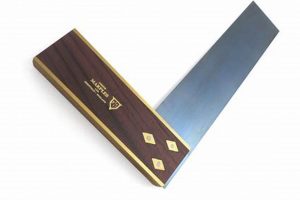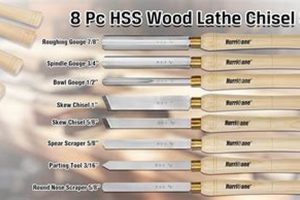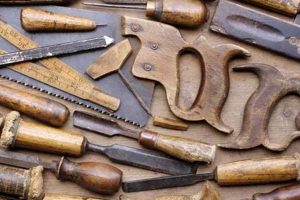A collection of implements designed for initiating the craft of shaping wood is essential for beginners. Such a set typically includes a variety of hand tools such as saws, chisels, measuring devices, and a sharpening stone. For instance, a basic collection might feature a crosscut saw, a bevel-edge chisel, a combination square, and a honing steel.
The significance of acquiring an initial set lies in establishing a foundation for skill development and project execution. These curated collections often provide cost-effectiveness compared to purchasing individual components and present a logical starting point for individuals entering the woodworking field. Historically, the presence of reliable hand tools has been fundamental to various woodworking applications, from constructing dwellings to crafting furniture.
The subsequent discussion will elaborate on the specific components commonly found within these collections, examining their functions and proper usage. Further analysis will address criteria for selecting an appropriate collection and guidance on maintaining tools for prolonged utility.
Guidance for Acquiring an Initial Woodworking Implement Collection
Prudent selection and maintenance of an initial set of woodworking implements significantly impacts the success and longevity of the craftsperson’s endeavors. Prioritizing quality and proper usage are paramount.
Tip 1: Prioritize Essential Tools: Focus on acquiring fundamental implements first. A saw, chisel, measuring square, and marking gauge constitute a core set for basic operations. Do not overextend the initial investment on specialized tools with limited immediate application.
Tip 2: Assess Material Quality: Examine the steel composition of cutting tools. High-carbon steel offers superior edge retention. Handle materials, such as hardwoods for chisels and saws, should provide a comfortable and secure grip.
Tip 3: Verify Accuracy of Measuring Instruments: Ensure the squareness of measuring tools. Inaccurate measurements lead to compromised joinery and flawed projects. Employ a known reference surface to validate squareness.
Tip 4: Learn Sharpening Techniques: Acquire a sharpening stone and practice honing cutting edges. Sharp tools are safer and more efficient. Dull tools require excessive force, increasing the risk of injury and producing inferior results.
Tip 5: Store Tools Properly: Establish a designated storage location to protect tools from damage and corrosion. A tool chest or wall-mounted rack is recommended.
Tip 6: Gradually Expand the Collection: As skill progresses and project demands evolve, incrementally add specialized implements. Resist the urge to amass a large collection prematurely.
Tip 7: Consider Pre-Owned Options: Explore the acquisition of vintage tools. Often, older implements, particularly hand planes, possess superior quality compared to contemporary budget offerings. Thorough inspection and restoration may be required.
Adhering to these guidelines will facilitate the development of a functional and reliable collection of woodworking implements, optimizing both safety and productivity.
The subsequent section will address advanced woodworking techniques and explore the utilization of power tools in conjunction with the foundational skills acquired using hand tools.
1. Essential Hand Tools
The selection of essential hand tools forms the core of any woodworking tools starter kit. These implements provide the fundamental means to shape, join, and finish wood, establishing a basis for both basic and advanced woodworking techniques. Their quality and suitability directly influence the success and safety of early projects.
- The Saw
A saw is paramount for cutting wood to the required dimensions. Within a starter collection, this typically includes a hand saw for general-purpose cuts and potentially a smaller backsaw for finer, more precise work like dovetails. The saw’s tooth configuration and blade sharpness dictate the efficiency and cleanliness of the cut. A dull or inappropriate saw hinders progress and increases the likelihood of errors.
- The Chisel
The chisel enables shaping wood, creating joints, and removing waste material. A bevel-edge chisel is a versatile option for a starter kit, capable of both paring and chopping. The chisel’s sharpness and the user’s control dictate the precision of the resulting shape. Inadequate sharpening techniques or improper usage can damage the tool or lead to inaccurate results.
- The Measuring and Marking Instruments
Accurate measurements are crucial for precise woodworking. A combination square, measuring tape, and marking gauge are essential for establishing dimensions and transferring them to the workpiece. The reliability of these instruments directly impacts the fit and finish of the final product. A poorly calibrated square, for example, will consistently generate skewed results.
- The Sharpening Stone
Maintaining sharp cutting edges is fundamental to safe and efficient woodworking. A sharpening stone, along with honing techniques, enables the user to restore the cutting edge of saws and chisels. A dull tool requires excessive force, increasing the risk of injury and producing subpar results. Mastery of sharpening techniques is a critical skill for any woodworker, irrespective of experience level.
These essential hand tools, when selected with consideration for quality and maintained with diligence, provide a solid foundation for the novice woodworker. Their effective utilization, fostered through practice and instruction, allows for the gradual development of woodworking skills and the confident undertaking of increasingly complex projects. The addition of further tools and equipment should be guided by the evolving needs of the individual and the specific demands of their woodworking pursuits.
2. Safety Equipment Included
The inclusion of safety equipment within a woodworking tools starter kit represents a crucial consideration, directly impacting the well-being of the individual undertaking woodworking activities. The inherent nature of woodworking, involving sharp implements and the generation of particulate matter, necessitates appropriate protective measures. Absence of adequate safety equipment exposes the user to significant risk of injury, ranging from lacerations and eye damage to respiratory complications. The presence of items like safety glasses, a dust mask, and potentially work gloves within such a kit aims to mitigate these hazards. For instance, flying wood chips produced by sawing or chiseling operations pose a direct threat to ocular health, rendering safety glasses an indispensable component.
Furthermore, the inhalation of wood dust, a common byproduct of sanding and cutting, can lead to respiratory irritation and long-term health issues. The inclusion of a dust mask serves to filter airborne particles, minimizing exposure and protecting the respiratory system. Work gloves, while perhaps less critical than eye and respiratory protection, offer a degree of safeguarding against splinters and minor cuts. The practical significance lies not only in preventing immediate injury but also in fostering a culture of safety from the outset of a woodworker’s experience. This proactive approach encourages responsible practices and reduces the likelihood of accidents over time.
In conclusion, safety equipment’s presence within a woodworking tools starter kit is not merely an ancillary addition but an integral component of responsible woodworking practice. It reflects a commitment to prioritizing user safety and facilitating a sustainable engagement with the craft. The challenge remains in ensuring that included safety equipment meets established standards and that users are properly instructed on its correct usage, further emphasizing the importance of informed decision-making when selecting such a starter kit.
3. Material Quality Assessment
Material quality assessment constitutes a critical stage in the selection process for a woodworking tools starter kit. The durability, performance, and safety of woodworking implements are directly proportional to the quality of materials used in their construction. Consequently, careful evaluation is essential to ensure a worthwhile investment and a safe working environment.
- Steel Composition in Cutting Tools
The type of steel utilized in the manufacture of saw blades, chisels, and plane irons significantly impacts their edge retention, sharpness, and resistance to corrosion. High-carbon steel, for example, generally offers superior hardness and edge retention compared to lower-grade steel alloys. A starter kit containing tools fabricated from inferior steel will necessitate more frequent sharpening and may exhibit a shorter lifespan. Consider the temper of the steel as well; properly tempered steel resists chipping and cracking under stress.
- Handle Materials and Construction
The material composition and construction of tool handles influence user comfort, grip, and overall control. Hardwoods, such as oak or maple, are commonly employed due to their durability and resistance to splitting. Plastic handles, while potentially more economical, may lack the ergonomic properties and longevity of their wooden counterparts. The manner in which the handle is attached to the tool head is also a crucial consideration. A poorly secured handle can lead to instability during use, increasing the risk of accidents.
- Material Integrity of Measuring Instruments
The accuracy of measuring instruments, such as squares and rulers, hinges directly on the material’s dimensional stability. Warping or bending of these tools will result in inaccurate measurements and compromised project outcomes. Look for measuring tools constructed from hardened steel or high-quality aluminum, ensuring they maintain their shape and accuracy over time. Check for clear, precise markings that are resistant to wear.
- Hardware and Fastener Quality
The durability of any clamps, vises, or other ancillary components within the starter kit relies on the quality of their hardware and fasteners. Cheaply made screws, bolts, and hinges are prone to stripping, breaking, or corroding, compromising the functionality of the tool. Examine the materials for signs of rust, pitting, or other defects. Consider the threading and overall fit of fasteners to ensure they provide a secure and reliable connection.
The long-term utility and safety of a woodworking tools starter kit depend substantially on the quality of the materials utilized in its constituent parts. A thorough material quality assessment, encompassing steel composition, handle construction, measuring instrument integrity, and hardware quality, is vital for informed purchasing decisions and the establishment of a solid foundation in the craft of woodworking. Investing in higher-quality materials, even at a slightly higher initial cost, often translates into long-term cost savings due to increased tool longevity and reduced maintenance requirements.
4. Sharpening and Maintenance
The longevity and efficacy of tools within a woodworking tools starter kit are inextricably linked to consistent sharpening and maintenance. Without appropriate upkeep, even high-quality implements rapidly degrade, diminishing their performance and potentially creating unsafe working conditions. A dull chisel, for example, necessitates increased force to cut, elevating the risk of slippage and subsequent injury. Similarly, a saw with blunt teeth will bind in the wood, producing rough, inaccurate cuts and demanding excessive physical exertion. Therefore, the inclusion of sharpening tools and the adoption of regular maintenance practices are not merely supplementary; they are fundamental components of a functional woodworking tools starter kit. A typical starter kit might contain a sharpening stone (either oil or water-based), honing oil or water, and perhaps a honing guide to assist in maintaining the correct bevel angle. The absence of these items, or a lack of understanding regarding their use, effectively negates the value of the cutting tools themselves.
The practical application of sharpening and maintenance extends beyond mere tool preservation. Properly sharpened tools produce cleaner, more precise cuts, leading to improved project outcomes. For instance, a precisely honed chisel allows for the creation of tight-fitting joinery, such as dovetails, that are both aesthetically pleasing and structurally sound. Furthermore, efficient maintenance reduces the overall cost of woodworking by extending the lifespan of the tools and minimizing the need for premature replacement. Simple tasks such as wiping down tools after use to prevent rust, lubricating moving parts, and storing tools properly contribute significantly to their long-term performance and reliability. Conversely, neglecting maintenance leads to rust, corrosion, and eventual tool failure, incurring unnecessary expense and impeding progress.
In summary, sharpening and maintenance are not optional extras but integral prerequisites for realizing the full potential of a woodworking tools starter kit. Neglecting these aspects undermines the investment in the kit and compromises both safety and project quality. The challenge lies in educating new woodworkers about the importance of these practices and equipping them with the necessary tools and knowledge to perform them effectively. This proactive approach ensures that the starter kit provides a solid foundation for developing woodworking skills and enjoying a fulfilling and safe woodworking experience.
5. Project Suitability
Project suitability, in the context of a woodworking tools starter kit, directly influences the success and satisfaction of the beginning woodworker. The efficacy of a starter kit hinges on its capacity to facilitate the completion of appropriate projects for a novice skill level. An ill-matched selection of tools can lead to frustration, inaccurate results, and potentially dangerous situations. For example, a kit lacking a suitable saw for cutting thicker stock would preclude the construction of even basic items such as small boxes or shelves. Conversely, a kit laden with specialized tools for advanced joinery would be overwhelming and largely unusable for a beginner whose projects primarily involve simple cuts and assembly.
The selection of tools within a starter kit should align with the common introductory woodworking projects, such as building small boxes, cutting boards, or simple frames. The inclusion of a basic hand saw, chisels for removing small amounts of material, and accurate measuring and marking tools enables the completion of these foundational projects. Understanding the correlation between project complexity and the tool set’s capabilities is crucial. Attempting a project beyond the starter kit’s capacity will invariably lead to subpar results and potentially damage the tools themselves. The practical significance lies in fostering a sense of accomplishment and building confidence through the successful completion of attainable projects, thereby encouraging continued skill development.
In summary, the concept of project suitability represents a critical consideration in the selection of a woodworking tools starter kit. The correlation between tool capabilities and project demands must be carefully assessed to ensure a positive and productive learning experience. The goal is to provide a set of tools that empowers the beginner to tackle appropriate projects with confidence, while simultaneously laying a foundation for future skill progression. The absence of this alignment can lead to discouragement and abandonment of the craft.
6. Storage Solutions
The connection between storage solutions and a woodworking tools starter kit is one of consequential interdependence. The tools included in such a kit, while essential for woodworking tasks, necessitate appropriate storage to maintain their condition and ensure user safety. Improper storage leads to tool damage, corrosion, and increased risk of injury. A starter kit’s efficacy is diminished if the included implements are not adequately protected. For example, a damp environment can cause rust on saw blades and chisel edges, rendering them less effective and requiring more frequent sharpening. Likewise, carelessly storing sharp tools poses a clear danger, especially in shared workspaces or households with children.
Effective storage solutions encompass various options, ranging from dedicated tool chests and cabinets to simpler solutions such as wall-mounted racks and tool rolls. The specific choice depends on factors such as available space, budget, and the volume of tools within the kit. The organization provided by these storage solutions is equally critical. A well-organized storage system facilitates efficient tool retrieval, reducing wasted time and minimizing the likelihood of misplacing components. Consider the example of a beginner consistently searching for a specific screwdriver, which delays project completion and generates frustration. A properly organized storage system, however, allows for quick and easy access to the required implement.
In conclusion, the inclusion or consideration of storage solutions is not merely an ancillary aspect of a woodworking tools starter kit, but an integral element that directly impacts the longevity of the tools, the safety of the user, and the overall efficiency of woodworking activities. Neglecting this aspect undermines the initial investment in the starter kit and compromises the user’s ability to develop their woodworking skills effectively. Therefore, prospective purchasers should prioritize storage options alongside the selection of tools themselves, ensuring a comprehensive and sustainable approach to the craft.
Frequently Asked Questions
The following addresses common inquiries regarding initial collections of woodworking implements, providing clarity on their composition, selection, and utilization.
Question 1: What constitutes a fundamental woodworking tools starter kit?
A core collection typically includes a hand saw, a set of chisels, a measuring square, a marking gauge, and a sharpening stone. This selection provides a basis for cutting, shaping, measuring, and maintaining essential tool edges.
Question 2: Is the purchase of a pre-assembled kit more advantageous than acquiring individual tools?
A pre-assembled kit offers the benefit of cost-effectiveness and coordinated selection. However, individual acquisition allows for greater control over tool quality and specialization to specific project needs.
Question 3: What attributes define high-quality hand tools?
Key indicators include the steel composition of cutting edges, the handle material and construction, and the precision of measuring instruments. High-carbon steel, hardwood handles, and hardened steel squares denote superior quality.
Question 4: How frequently should woodworking tools be sharpened?
Sharpening frequency depends on tool usage and material hardness. A discernible dulling of the cutting edge necessitates immediate attention. Consistent honing helps maintain sharpness and prolong tool life.
Question 5: What safety precautions are paramount when utilizing woodworking tools?
Eye protection, respiratory protection, and secure workholding are essential. Furthermore, maintaining sharp tools and avoiding excessive force mitigate the risk of injury.
Question 6: How does one effectively store woodworking tools to prevent damage?
Tools should be stored in a dry environment, protected from physical impact. Individual tool sleeves, tool chests, or wall-mounted racks prevent corrosion and maintain edge integrity.
In summary, understanding the components, quality, maintenance, and safety aspects of a woodworking tools starter kit is crucial for establishing a safe and productive woodworking practice.
The subsequent section will explore advanced woodworking techniques and the integration of power tools into a well-rounded woodworking skillset.
Woodworking Tools Starter Kit
This exploration has underscored the fundamental role of a woodworking tools starter kit in initiating individuals into the craft. A well-chosen and maintained collection of implements not only facilitates the execution of basic woodworking tasks but also lays the groundwork for developing more advanced skills. The quality of materials, the inclusion of necessary safety equipment, and the adoption of proper maintenance practices are critical determinants of long-term success and safety.
The selection of a starter kit should be viewed as an investment in both the craft and the individual’s potential. Continued learning, diligent practice, and a commitment to safety will ensure that the initial collection serves as a solid foundation for a lifetime of woodworking endeavors. The pursuit of woodworking demands respect for the tools, the materials, and the process itself, leading to creations of lasting value and personal fulfillment.







